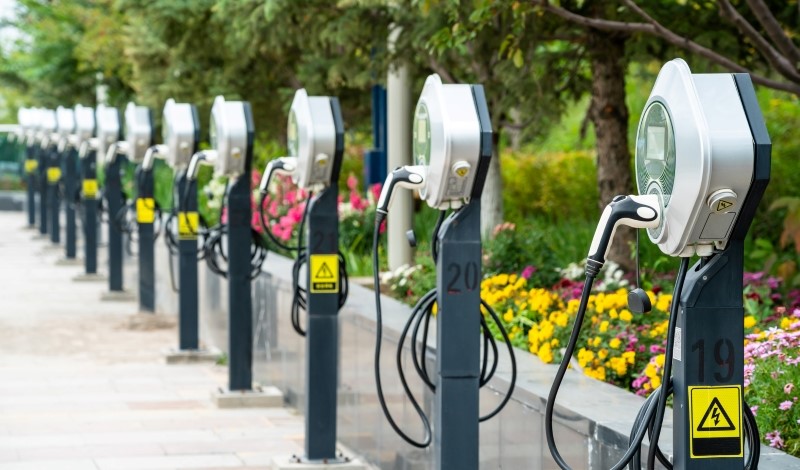
Scholar urges federal land regulators to protect Native American communities from mining harms expected from the transition to electric vehicles.
Over the past several years, electric vehicles (EVs) have taken the United States by storm; EV sales more than doubled between 2020 and 2021 alone. Although climate scientists emphasize that transitioning to EVs is key to addressing the climate crisis, EVs rely on batteries made from minerals such as nickel, copper, and lithium, each of which carries its own environmental costs.
Society at large will reap the benefits of the EV transition, but certain communities may bear a disproportionate share of the environmental burdens associated with EVs, argues Lisa Benjamin, professor at Lewis and Clark Law School. In a forthcoming article, Benjamin calls upon the Bureau of Land Management (BLM) to reduce the likely environmental disparities created by EV technology.
Given the high percentage of mineral deposits on tribal lands, Benjamin urges the BLM not to overlook the interests of Native American communities as demand for the minerals used in electric vehicles increases. To that end, Benjamin recommends that the BLM adopt regulations prohibiting mining operations that would pose “substantial irreparable harm” to tribal land and cultural or sacred sites.
Benjamin acknowledges the critical role that EVs will play in combating the climate crisis. EVs dramatically reduce the amount of carbon dioxide emitted by cars powered by fossil fuels such as gasoline or diesel. Carbon dioxide, like all greenhouse gases (GHGs), contributes to climate change by trapping heat in the earth’s atmosphere. Because the transportation sector currently constitutes the largest source of U.S. GHG emissions, transitioning all U.S. vehicles to EVs powered by clean energy could reduce GHG emissions from road transportation by 82 percent by 2050.
The EV transition—a cornerstone of President Joseph R. Biden’s climate agenda—is well underway. EVs already constitute 9 percent of the global car market, a percentage that is projected to reach 43 percent by 2035. As demand for EVs increases, so too will demand for the minerals they rely upon. The Biden Administration projects, for example, that the EV transition will create a 400 percent to 600 percent increase in demand for lithium, graphite, cobalt, and nickel over current levels of global demand.
Against this backdrop, Benjamin argues that now is the time to reform federal mining regulations to ensure that the EV transition is carried out in accordance with environmental justice principles—principles that provide for the equitable distribution of the burdens associated with climate policies. Because the vast majority of nickel, copper, and lithium deposits in the United States are located within 35 miles of Native American reservations, Benjamin warns that Native communities are especially at risk of bearing a disproportionate share of the environmental costs associated with the EV transition.
Benjamin emphasizes that mining imposes a variety of environmental harms on surrounding communities. Benjamin explains that mining can produce cadmium, arsenic, mercury, and lead pollution and often depletes local water resources. In addition, mining changes the landscape and has historically caused irreparable harm to certain Native communities’ sacred and cultural sites.
To ensure that the interests of Native communities are considered during the EV transition, Benjamin recommends that the BLM adopt more stringent requirements prohibiting mining not only at sacred sites on reservations but also in any adjacent areas deemed culturally important. Benjamin specifically calls for reform of the Federal Land Policy and Management Act of 1976, which authorizes the BLM to deny permitting requests for mining projects that would cause “unnecessary or undue degradation” of public lands.
In 2000, the Clinton Administration established a new regulatory standard that provided that the BLM would deny a mining permit if operations would result in “substantial irreparable harm” to the developed land or nearby scientific, cultural, and environmental resources. In 2001, however, the George W. Bush Administration removed the standard’s language about substantial irreparable harm, adopting instead what Benjamin calls a more permissive standard of what constitutes “unnecessary or undue degradation.”
Benjamin urges the BLM under President Biden to reissue the Clinton Administration rule and bring back the “substantial irreparable harm” standard, which the BLM itself has recognized is favored by Native American communities. Benjamin explains that returning to the “substantial irreparable harm” standard would better protect sacred and cultural sites from mining operations, thereby helping to mitigate the “imbalance and burdens that the transition to EVs is likely to bring to Native communities.”
Beyond advocating more stringent mining regulations, Benjamin also recommends that the BLM take steps to increase Native participation in the agency’s decision-making procedures. Tribal nations are sovereign and agencies are already legally obligated, as a result, to engage in “tribal consultations” before taking action that imposes “substantial direct effects” on Native American communities. Tribal consultations, however, do not always result in meaningful tribal participation in the development of agency policies, according to Benjamin.
To address this lack of meaningful participation, she argues that BLM should strengthen its tribal consultation process and foster a more collaborative relationship with Native communities. The BLM, Benjamin suggests, could allow Native communities to nominate culturally important landscapes located off reservations for heightened protection from development. Likewise, the agency also could integrate Native American governments into land management programs.
Although the EV transition is expected to bring significant climate benefits, Benjamin urges the BLM to take steps to anticipate and mitigate the harms that this transition may impose on particular communities. She warns that, should the BLM fail to do so, the EV transition may replicate the “exploitative extraction” practices that characterized the fossil fuel era.



